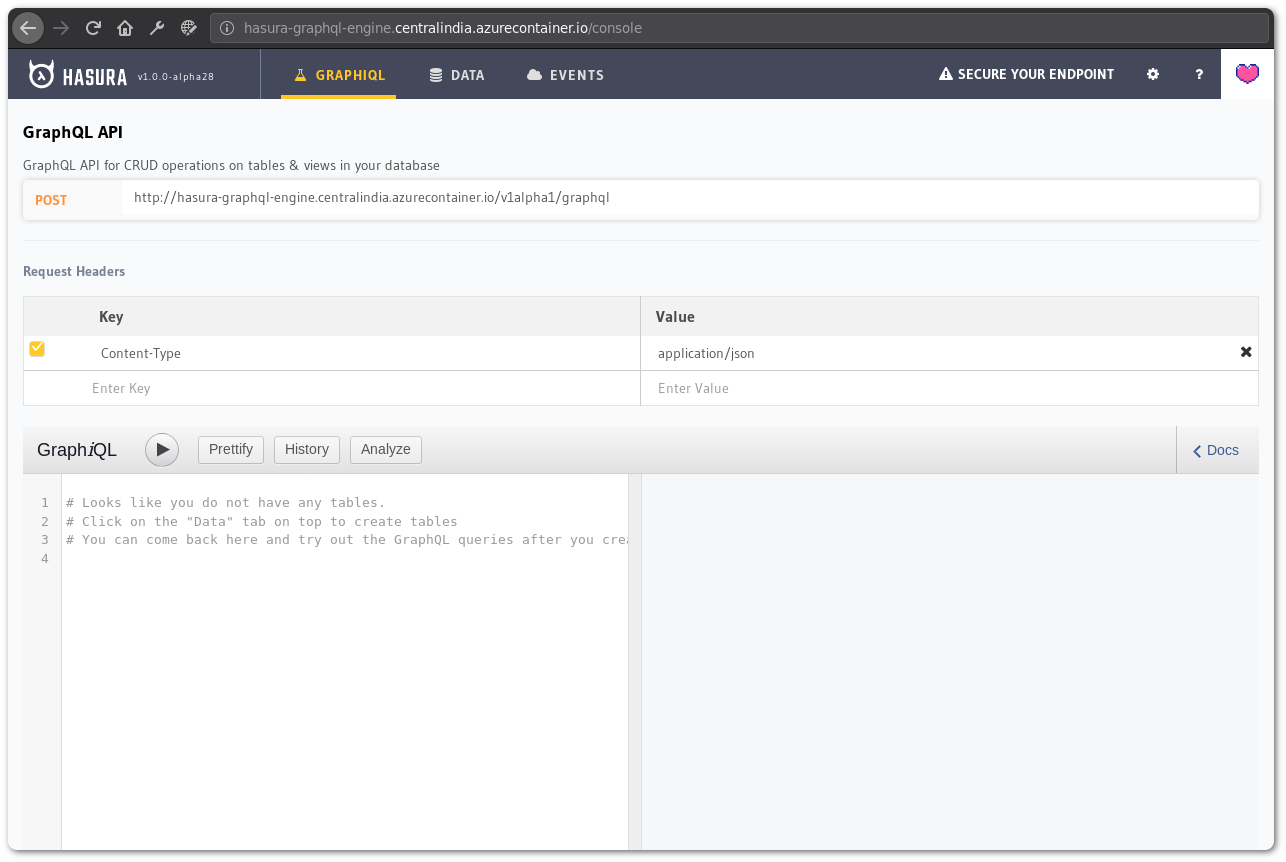Hasura GraphQL engine on Azure with Container Instances and Postgres
Introduction
This guide walks you through deploying the Hasura GraphQL engine on Azure using Container Instances with Azure Database for PostgreSQL server.
One-click deployment using ARM Template
You can deploy all the resources mentioned in this guide with the one-click button below.
- With a new Postgres Server
- With an existing Postgres Server
Pre-requisites
- Valid Azure subscription with billing enabled or credits (click here for a free trial).
- Azure CLI.
The actions mentioned below can be executed using the Azure Portal and the Azure CLI. But for the sake of simplicity in documentation, we are using Azure CLI; so that commands can be easily copy-pasted and executed.
Once you install the CLI, login to your Azure account:
az login
Create a new Resource Group
The Resource Groups are used to group various resources on Azure. Create a resource group called hasura at the
westus location.
az group create --name hasura --location westus
Provision a PostgreSQL server
If you already have a database setup, you can skip these steps and jump directly to Allow access to Azure Services.
After you create the resource group, create a Postgres server instance:
az postgres server create --resource-group hasura \
--name "<server_name>" \
--location westus \
--admin-user hasura \
--admin-password "<server_admin_password>" \
--sku-name GP_Gen5_2 \
--version 10
- Choose a unique name for
<server_name>variable. - Select a strong password for the
<server_admin_password>variable, that must include uppercase, lowercase, and numeric characters. You will need the password later to connect to the database. (make sure you escape the special characters depending on your shell).
Note the hostname in the output, as indicated below:
...
"fullyQualifiedDomainName": "<server_name>.postgres.database.azure.com",
...
where; <server_name>.postgres.database.azure.com is the hostname.
If you get an error saying Specified server name is already used, change the value of --name (<server_name>) to
something else.
Create a new database
Create a new database on the server:
az postgres db create --resource-group hasura \
--server-name "<server_name>" \
--name hasura
Allow access to Azure Services
Create a firewall rule allowing access from Azure internal services:
az postgres server firewall-rule create --resource-group hasura \
--server-name "<server_name>" \
--name "allow-azure-internal" \
--start-ip-address 0.0.0.0 \
--end-ip-address 0.0.0.0
Create a Container Instance
Launch Hasura using a container instance:
az container create --resource-group hasura \
--name hasura-graphql-engine \
--image hasura/graphql-engine \
--dns-name-label "<dns-name-label>" \
--ports 80 \
--environment-variables "HASURA_GRAPHQL_SERVER_PORT"="80" "HASURA_GRAPHQL_ENABLE_CONSOLE"="true" "HASURA_GRAPHQL_ADMIN_SECRET"="<admin-secret>"\
--secure-environment-variables "HASURA_GRAPHQL_DATABASE_URL"="<database-url>"
<database-url> should be replaced by the following format:
postgres://hasura%40<server_name>:<server_admin_password>@<hostname>:5432/hasura
If you'd like to connect to an existing database, use that server's database url.
%40 is used in the username because Azure creates usernames as admin-user@server-name and since the database url
uses @ to separate username-password from hostname, we need to url-escape it in the username. Any other special
character should be url-encoded.
If the <dns-name-label> is not available, choose another unique name and execute the command again.
Setting up JWT
Use the HASURA_GRAPHQL_JWT_SECRET env variable to setup JWT. To generate a new JWT config refer
here.
The HASURA_GRAPHQL_JWT_SECRET env variable requires JSON format. To create a container group with
az container create --environment-variables flag you need to pass the variable as a key-value pair.
In order to use the env variable with the az container create command, pass the JSON value for the env
variable as a string by escaping the characters like so:
az container create --resource-group hasura \
--name hasura-graphql-engine \
--image hasura/graphql-engine \
--dns-name-label "<dns-name-label>" \
--ports 80 \
--environment-variables "HASURA_GRAPHQL_SERVER_PORT"="80" \
"HASURA_GRAPHQL_ENABLE_CONSOLE"="true" \
"HASURA_GRAPHQL_ADMIN_SECRET"="<admin-secret>" \
"HASURA_GRAPHQL_JWT_SECRET"= \ "{\"type\": \"RS512\",\"key\": \"-----BEGIN CERTIFICATE-----\\nMIIDBzCCAe+gAwIBAgIJTpEEoUJ/bOElMA0GCSqGSIb3DQEBCwUAMCExHzAdBgNV\\nBAMTFnRyYWNrLWZyOC51cy5hdXRoMC5jb20wHhcNMjAwNzE3MDYxMjE4WhcNMzQw\\nMzI2MDYxMjE4WjAhMR8wHQYDVQQDExZ0cmFjay1mcjgudXMuYXV0aDAuY29tMIIB\\nIjANBgkqhkiG9w0BAQEFAAOCAQ8AMIIBCgKCAQEAuK9N9FWK1hEPtwQ8ltYjlcjF\\nX03jhGgUKkLCLxe8q4x84eGJPmeHpyK+iZZ8TWaPpyD3fk+s8BC3Dqa/Sd9QeOBh\\nZH/YnzoB3yKqF/FruFNAY+F3LUt2P2t72tcnuFg4Vr8N9u8f4ESz7OHazn+XJ7u+\\ncuqKulaxMI4mVT/fGinCiT4uGVr0VVaF8KeWsF/EJYeZTiWZyubMwJsaZ2uW2U52\\n+VDE0RE0kz0fzYiCCMfuNNPg5V94lY3ImcmSI1qSjUpJsodqACqk4srmnwMZhICO\\n14F/WUknqmIBgFdHacluC6pqgHdKLMuPnp37bf7ACnQ/L2Pw77ZwrKRymUrzlQID\\nAQABo0IwQDAPBgNVHRMBAf8EBTADAQH/MB0GA1UdDgQWBBSOG3E+4lHiI+l0i91u\\nxG2Rca2NATAOBgNVHQ8BAf8EBAMCAoQwDQYJKoZIhvcNAQELBQADggEBAKgmxr6c\\nYmSNJOTPtjMFFDZHHX/7iwr+vqzC3nalr6ku8E3Zs0/IpwAtzqXp0eVVdPCWUY3A\\nQCUTt63GrqshBHYAxTbT0rlXFkqL8UkJvdZQ3XoQuNsqcp22zlQWGHxsk3YP97rn\\nltPI56smyHqPj+SBqyN/Vs7Vga9G8fHCfltJOdeisbmVHaC9WquZ9S5eyT7JzPAC\\n5dI5ZUunm0cgKFVbLfPr7ykClTPy36WdHS1VWhiCyS+rKeN7KYUvoaQN2U3hXesL\\nr2M+8qaPOSQdcNmg1eMNgxZ9Dh7SXtLQB2DAOuHe/BesJj8eRyENJCSdZsUOgeZl\\nMinkSy2d927Vts8=\\n-----END CERTIFICATE-----\"}"
--secure-environment-variables "HASURA_GRAPHQL_DATABASE_URL"="<database-url>"
Check out the Running with JWT section for the usage of
HASURA_GRAPHQL_JWT_SECRET env variable.
Open the Hasura Console
That's it! Once the deployment is complete, navigate to the container instance's IP or hostname to open the Hasura console:
az container show --resource-group hasura \
--name hasura-graphql-engine \
--query "{FQDN:ipAddress.fqdn,ProvisioningState:provisioningState}" \
--out table
The output will contain the FQDN in the format <dns-name-label>.westus.azurecontainer.io.
Visit the following URL for the Hasura console:
http://<dns-name-label>.westus.azurecontainer.io/console
Replace <dns-name-label> with the label given earlier.

You can create tables and test your GraphQL queries here.
Troubleshooting
If your password contains special characters, check if the password is URL encoded and given as env variables. Also, check for proper escaping of these characters based on your shell.
You can check the logs to see if the database credentials are proper and if Hasura is able to connect to the database.
If you're using an existing/external database, make sure the firewall rules for the database allows connection for Azure services.
Checking logs
If the console doesn't load, check the logs:
az container logs --resource-group hasura \
--name hasura-graphql-engine \
--container-name hasura-graphql-engine
# use --follow flag to stream logs
Tearing down
To clean up the deployment, delete the resource group:
az group delete --resource-group hasura

